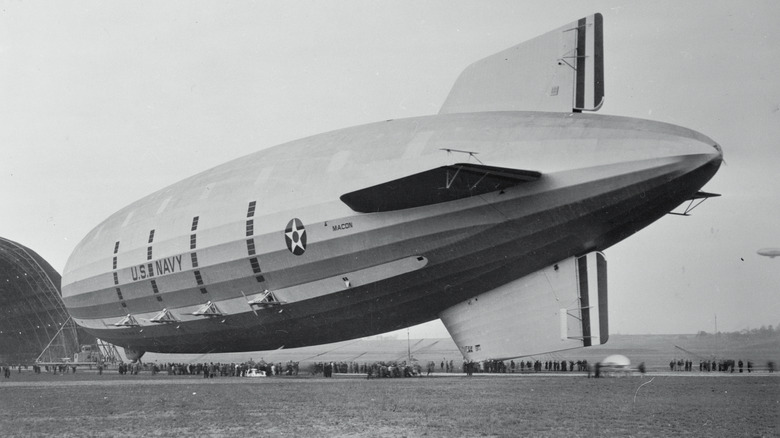The Tragic Reason The US Navy Stopped Making Flying Aircraft Carrier Airships
Militaries all around the world are always trying to revolutionize the vessels at their disposal. Some have heard about the Japanese I-400 submarine aircraft carrier or America's ingenious submarine designed to carry planes deep underwater. Playing with aircraft carrier designs is nothing new, but transporting planes underwater wasn't the only unique idea the U.S. Navy had. There was once an attempt to take aircraft carriers to the skies, much like audiences have seen in Marvel's "Avengers" films. In 1931, the USS Akron, a 785-foot-long zeppelin, took flight with 100 passengers aboard. The Akron and its eventual sister ship were designed to carry aircraft and drop them from the sky rather than launch them from the ground.
Unlike carriers that sail on the oceans today, these airships were primarily designed for reconnaissance missions and only carried two bi-planes. Unfortunately, incident after incident got the American government rethinking its plans for a fleet of these airships. The Akron traversed from New Jersey to San Diego, California in 1932 that ended in tragedy. When it reached its west coast destination, weather was not on its side. During landing procedures, the tail shot up and threatened to land on its nose.
Three men in charge of holding onto the mooring lines were caught off guard and failed to release the lines in time. One man fell from 15 feet, breaking his arm. The other two, unfortunately, fell from 100 and 200 feet, dying on impact. This would be the first of a series of tragedies that would end the aircraft carrying airship experiment.
Further tragedies
That wasn't the only tragedy to befall the USS Akron. A storm in 1933 over New Jersey caused the airship to crash, killing 73 people, including the Chief of the Bureau of Aeronautics, Rear Admiral William Moffett. Only three people aboard the Akron walked away from that national disaster, including Akron's executive officer, Lt. Cmdr. Herbert Wiley. Wiley went on to take command of Akron's sister ship, the USS Macon. Unfortunately, the Macon itself didn't fair any better.
The Macon had to perform an emergency landing in 1935 after a storm off the coast of California ripped its fin clean off. The navy learned a few lessons from the Akron accident, including adding life jackets and rafts to the airship in the event of a water incident, something that could have saved more lives on Akron. Because of these additions, only two sailors perished in the event. The remains of the Macon sank to a depth of 15,000 feet and haven't been recovered since.
While these two tragedies America's venture with flying aircraft carriers, it didn't stop using Zeppelins. Five different airship classes operated during World War II. That doesn't mean the U.S. government lost all interest in flying aircraft carriers, though. The USAF played with an idea that saw a strange little jet designed to launch from a bomber in the '40s, and then DARPA tested a drone that could take off and land in a large enough aircraft in 2019. So, America might give another go at some form of flying aircraft carriers.

